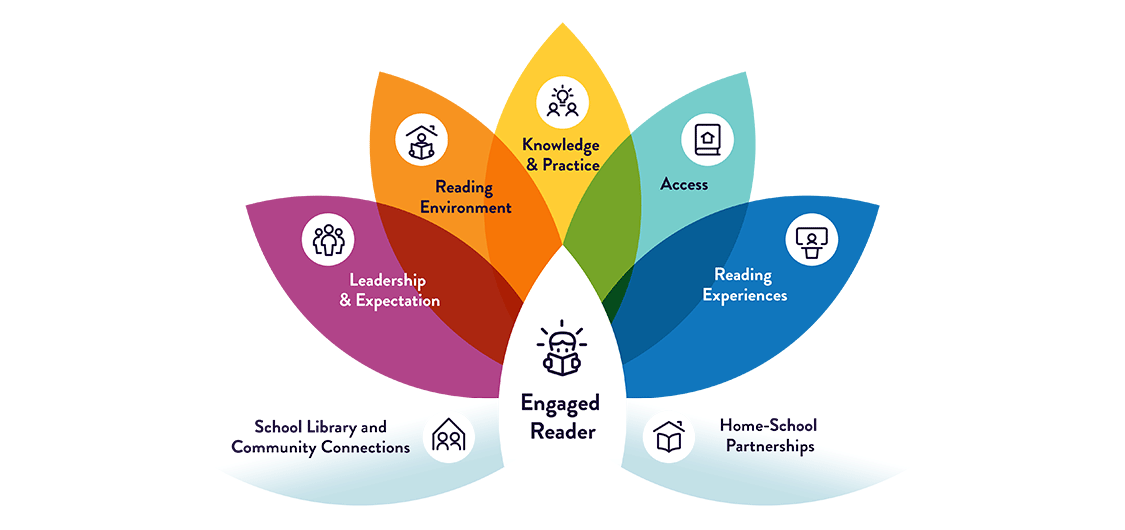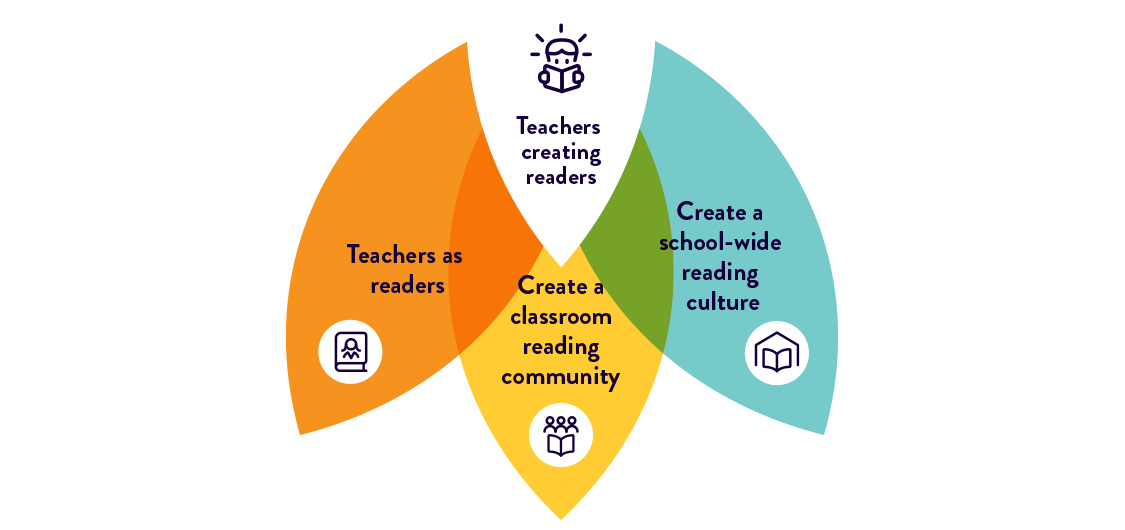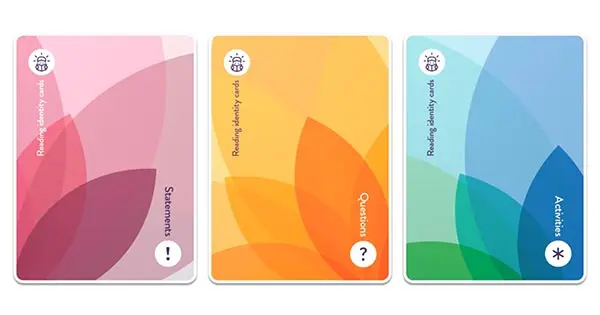Reading Identity Chatterbox template 1.

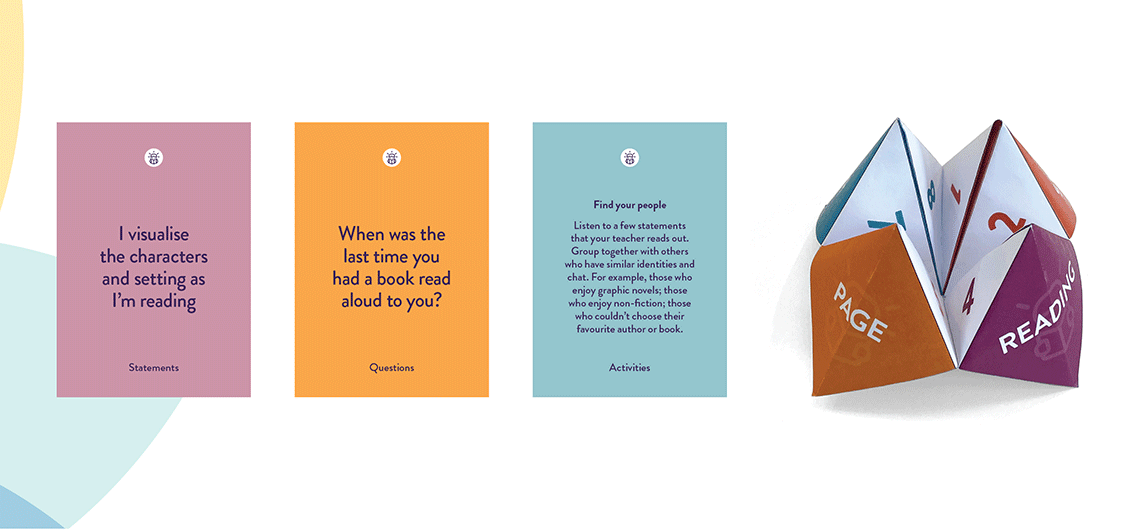
Download and print our Reading Identity Cards and Chatterbox. Use the statements, questions and activities to reflect on, develop and share your reading identity.
The Reading Identity Cards connect with the National Library’s Reading Community Framework — Knowledge and Practice. Reading identity is one specific focus in the Teachers Creating Readers Framework and is an integral part of being a reader. The cards are designed to help you reflect on, develop and share your reading identity and better support others to develop theirs.
Find out more about the:
Reading identity — who you are as a reader — is about your reading attitude, habits, behaviours, choices and motivation. Instead of using the question cards, use the chatterbox as another fun way to reflect on and build awareness of your reading identity whilst sharing it with others.
The chatterbox is designed to be used in small groups.
We have 4 chatterbox templates with different questions.
Or read the accessible web versions in this section.
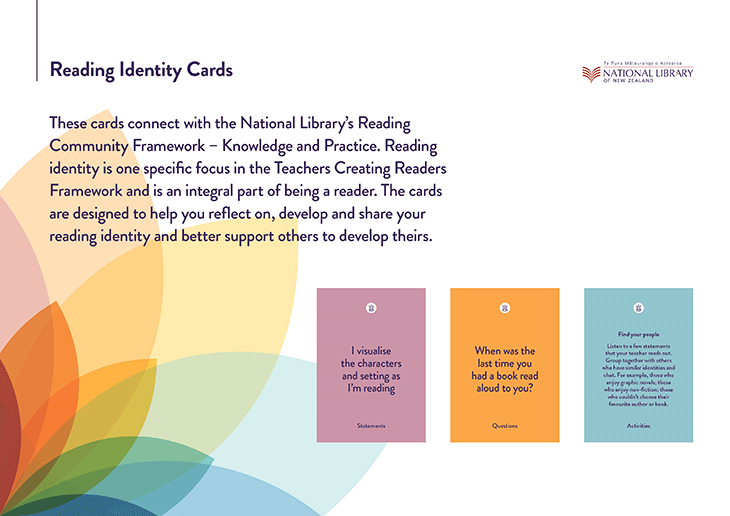
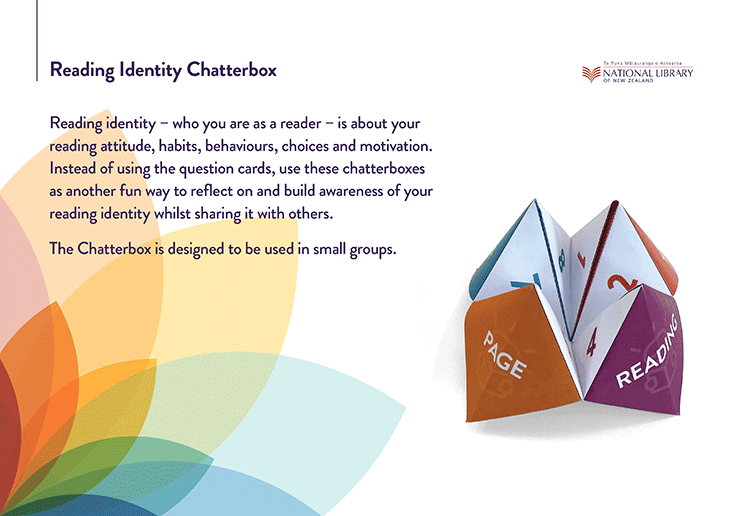
I sometimes read the end before I get there.
I skim over ‘boring’ parts.
I bend the corners of a page as a bookmark.
I don’t always finish a book.
I enjoy reading non-fiction books.
I track my reading in some way.
I like to read on a device.
I have people in my life who suggest books.
I will finish a series even if it’s not that good.
I borrow books from a library.
I only read when I’m on holiday.
I like to dip in and out of books.
Reading is a priority for me.
I like to read short stories.
I enjoy audiobooks.
I re-read favourites.
I read a range of genres.
I only read when I have to.
I have favourite authors/books.
I have happy reading memories.
I experience reading slumps.
I visualise the characters and setting as I’m reading.
I read while watching TV or listening to music.
I like books with fast plots.
I think the book is always better than the movie/TV version.
I like it when people read to me.
I like books with characters I can relate to.
I read to learn, relax, escape or …
I like books that help me escape into worlds not like my own.
I judge books by their cover.
I have a ‘to be read’ list.
I enjoy reading poetry.
I like to read before going to sleep.
I find it hard to read a whole book.
I sometimes read more than one book at a time.
I couldn’t choose a favourite (author, book, character, etc).
I can spend a long time in a bookshop or library.
I buy books even if I don’t need a new one.
I will only watch a screen version if I've read the book first.
I belong to a book club.
I will always finish a book.
I use receipts, loyalty cards etc as bookmarks.
I like books that make me emotional (angry, sad, happy, etc).
I like to make notes in my books.
I’ve always got a book with me (physical or digital).
I would like to read more but other things take priority.
I like to read books that don’t look too long.
I like to binge on a series and read them one after another.
Who would you trust to recommend a book to you?
How long do you give a book that you’re not enjoying?
Which genre and/or form do you most enjoy?
What is a book that you disliked but someone else really liked?
What book made you feel emotional (in a positive or negative way)?
Who do you talk to about books?
What is a book you’d recommend?
Who is a character that you had a strong reaction to (positively or negatively)?
What book-to-screen adaptation was okay or great?
Where is the most unusual place you have read a book?
What are your earliest reading experiences/memories?
How often do you read? What drives this?
Why did you choose the last book you read?
How do you choose books?
What stops you from reading?
Do you always finish a book?
Who in your home reads?
When was the last time you had a book read aloud to you?
What is on your ‘to be read’ list?
Who do you swap books with?
Where do you get your books from?
What’s the worst thing that’s happened to a book you’ve been reading?
What do you read that is not a book?
What story reflected a time in your life or someone you know?
What keeps you engaged in a story?
What is your ideal reading environment?
What do you want to read next?
How do you feel about reading when it’s noisy or quiet?
What books are you willing to re-read?
What features do you like when reading an eBook?
What do you do when reading that others may not like?
What do you use to mark your place in a book?
Explain to participants before you start that the aim of each activity is to get them thinking and discussing.
Sit in small groups, with cards placed face down. Turn over one card at a time and take turns discussing. Or each group discusses one card. Pass the card to the next table when you’re done.
Pick any four statements or questions. Then, choose one (or more) that resonates. Draw/bullet point/write about it. Turn and share with others.
Get into groups. Each group has access to statements as prompts (if needed) and an amount of time to discuss. Find three reading-related things you all have in common. For example, you may all have read or been read a Roald Dahl book in primary school.
Build a picture of your reading identity. Whenever your teacher asks questions or makes a statement, doodle/sketch/bullet point your ‘answers’ on the same page and date them. Your teacher may repeat statements/questions over the year as your reading identity can change.
Consider statements your teacher reads out or writes. Place them in yes/no/sometimes columns. Share statements that resonate with you (positively or negatively) in pairs, small groups or with the whole class.
Listen to statements/questions your teacher reads out. Stand along a line based on how strongly you feel about what your teacher read. Turn, discuss and share back to the whole group if comfortable. Discuss what factors may change where you decided to stand.
Your teacher has duplicated the question cards and given them out to the class. Walk around and ask other students your question. Continue until you find the person with the same question. Discuss.
Listen to a few statements your teacher reads out. Group with others who have similar identities and chat.
For example, those who:
enjoy graphic novels
enjoy non-fiction
couldn’t choose their favourite author or book.
Ask someone to pick a word that's written on one of the square pockets.
Open and close the chatterbox by spelling out the word.
Ask them to choose one of the numbers written inside, then open and close the chatterbox by counting out the chosen number.
Ask them to choose another number. Open it and read the question.
Instructions — assuming the art is face up:
Carefully cut the square template out of this sheet.
Fold the square sheet you have in half to make a rectangle.
Fold the rectangle in half to make a smaller square.
Unfold it all and lay it so the blank side is face up.
Fold each corner into the centre.
Turn the sheet over and fold each corner into the centre.
Fold this new square in half.
Slip your fingers under the paper tongues on the outside edges — and pinch or pull — the chatterbox will begin to take shape as you do.
Have fun.
Reading Identity Chatterbox template 1.

1 — Who do you talk to about books?
2 — What book made you feel emotional (in a positive or negative way)?
3 — What is a book that you disliked but someone else really liked?
4 — Which genre and/or form do you most enjoy?
5 — How long do you give a book that you’re not enjoying?
6 — Who would you trust to recommend a book to you?
7 — Who is a character that you had a strong reaction to (positively or negatively)?
8 — What is a book you’d recommend?
Reading Identity Chatterbox template 2.
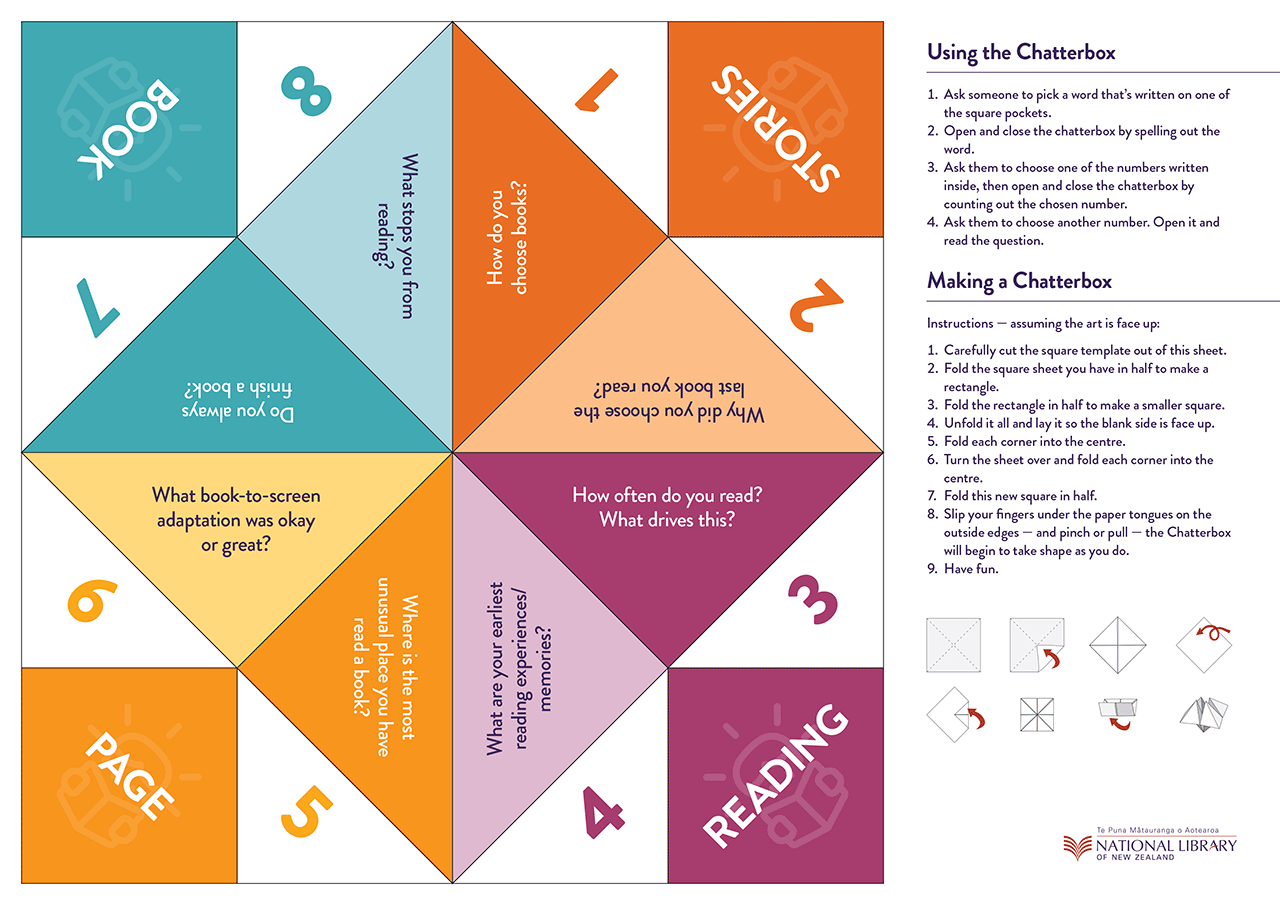
1 — How do you choose books?
2 — Why did you choose the last book you read?
3 — How often do you read? What drives this?
4 — What are your earliest reading experiences/memories?
5 — Where is the most unusual place you have read a book?
6 — What book-to-screen adaptation was okay or great?
7 — Do you always finish a book?
8 — What stops you from reading?
Reading Identity Chatterbox template 3.

1 — What’s the worst thing that’s happened to a book you’ve been reading?
2 — Where do you get your books from?
3 — Who do you swap books with?
4 — What is on your ‘to be read’ list?
5 — When was the last time you had a book read aloud to you?
6 — Who in your home reads?
7 — What story reflected a time in your life or someone you know?
8 — What do you read that is not a book?
Reading Identity Chatterbox template 4.
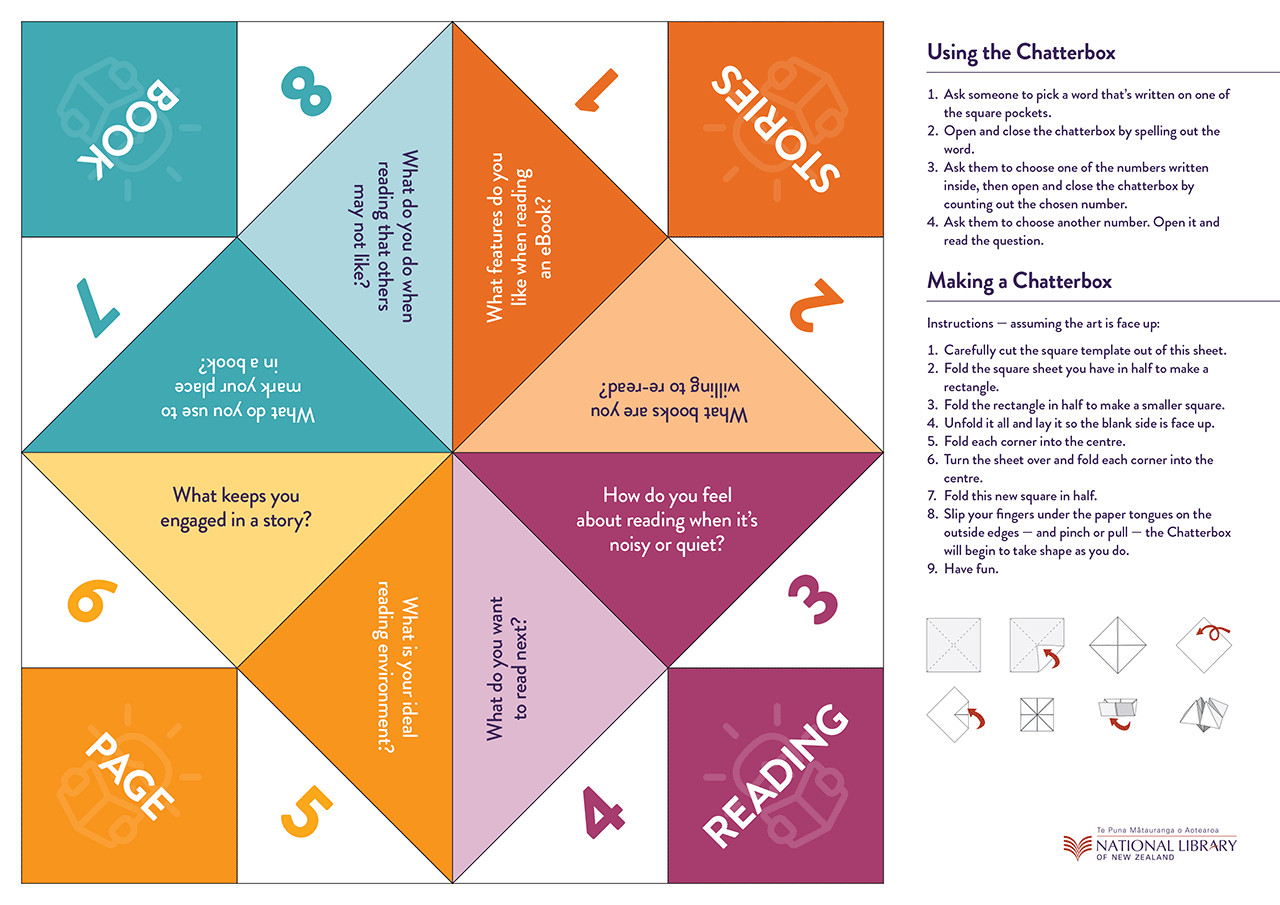
1 — What features do you like when reading an eBook?
2 — What books are you willing to re-read?
3 — How do you feel about reading when it’s noisy or quiet?
4 — What do you want to read next?
5 — What is your ideal reading environment?
6 — What keeps you engaged in a story?
7 — What do you use to mark your place in a book?
8 — What do you do when reading that others may not like?
Worked through the activities on the cards and want to do some more? Try the following with your students.
Do this activity alongside your school librarian.
Revise the card statements. For example, change ‘I don’t always finish a book’ to ‘Find a book that you didn’t finish’. Read out a statement and ask the students to find an example within the library.
Students return to a designated space and sit in small groups to share about the book and why they chose it. Students then return the book to the right place on the shelf.
Write the questions onto the sections of a beach ball or in the segments of a football etc.
Students stand in a circle and throw the ball to each other. The catcher answers the question that their index finger (or thumb) touches.
Continue until everyone has answered a question.
Students sit (or stand) in 2 lines facing each other. Read out a question or statement to them.
Students take turns discussing answers. One row then moves and begins again with a different question or statement. At the end, students could sketch/bullet point/draw etc their answers to refer to or reflect on.
To include a listening element, each student has a piece of paper with their name on it. At the end of the discussion, they hand their paper to their partner who writes down what they heard. You could increase the number of people they listen to before being able to write down answers.
Choose a range of reading questions. Write these onto A3 paper and place them around the room.
Each student gets 3 Post-it notes. They write their answers to 3 of the questions (include their name). Students place their Post-its onto the corresponding A3 sheet.
Give students time to walk around and read other answers before returning to one sheet of paper to discuss their answers with others who are standing there.
You may need to set some enabling constraints/expectations, such as making sure:
the final discussion place has no more than 2 of their friends
everyone is included and has someone to chat with.
Students stand in a circle (or a few smaller circles).
One person starts with a ball of wool/string. They make a statement related to their reading identity. For example, ‘I enjoy reading graphic novels’. Anyone in the circle who can ‘connect’ with their statement calls out ‘connect’. The person with the ball of wool/string holds the end of the wool/string and throws the ball to the person connecting with their statement.
The first person, then the second, briefly explains their answers. The second person now makes another statement and on it goes until everyone has connected.
Instead of using wool/string, you could get students to sit down once they’ve connected.
Students may find that others don’t ‘connect’ with some of their statements. That’s okay. Encourage them to think of a few before starting.
Duplicate the question cards and give them out to the class.
Students walk around and ask other students their question. They continue until they find the person with the same question and then discuss.
They then pair up with a different person who asked them a question. Students share their questions and discuss answers.
